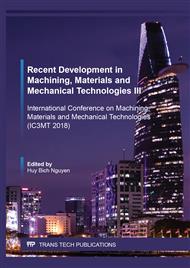[1]
M. Futamura, High-speed mirror finishing which combined fatigue life and sliding wear resistance improvement –Roller burnishing-, J. Jpn. Soc. Precis. Eng., 81 (2015) 1053-1056 (in Japanese).
DOI: 10.2493/jjspe.81.1053
Google Scholar
[2]
M. Okada, S. Suenobu, K. Watanabe, Y. Yamashita, N. Asakawa, Development and burnishing characteristics of roller burnishing method with rolling and sliding effects, Mechatron., 29 (2015) 110-118.
DOI: 10.1016/j.mechatronics.2014.11.002
Google Scholar
[3]
P. Balland, L. Tabourot, F. Degra, V. Moreau, An investigation of the mechanics of roller burnishing through finite element simulation and experiments, Int. J. Mach. Tools Manuf., 65 (2013) 29-36.
DOI: 10.1016/j.ijmachtools.2012.09.002
Google Scholar
[4]
P. Balland, L. Tabourot, F. Degre, V. Moreau, Mechanics of the burnishing process, Precis. Eng., 37 (2013) 129-134.
DOI: 10.1016/j.precisioneng.2012.07.008
Google Scholar
[5]
A. Saldaña-Robles, H. Plascencia-Mora, E. Aguilera-Gómez, A. Saldaña-Robles, A. Marquez-Herrera, J. A. Diosdado-De la Peña, Influence of ball-burnishing on roughness, hardness and corrosion resistance of AISI 1045 steel, Surf. Coat. Technol., 339 (2018) 191-198.
DOI: 10.1016/j.surfcoat.2018.02.013
Google Scholar
[6]
J. Zhao, Z. Lu, Investigations of ultrasonic frequency effects on surface deformation in rotary ultrasonic roller burnishing Ti-6Al-4V, Mater. Des., 107 (2016) 238-249.
DOI: 10.1016/j.matdes.2016.06.024
Google Scholar
[7]
Y. Tian, Y.C. Shin, Laser-assisted burnishing of metals, Int. J. Mach. Tools Manuf., 47 (2007) 14-22.
Google Scholar
[8]
M. Okada, M. Shinya, K. Takasugi, H. Tachiya, T. Sasaki, M. Otsu, Driven rotary tool burnishing with coated carbide tool –Influence of tool surface characteristics on burnished surface characteristics and clarification of tool wear behavior-, J. Jpn. Soc. Prec. Eng., 83 (2017) 694-700 (in Japanese).
DOI: 10.2493/jjspe.83.694
Google Scholar
[9]
L. Luca, S. Neagu-Ventzel, L. Marinescu, Effects of working parameters on surface finish in ball-burnishing of hardened steels, Prec. Eng., 29 (2005) 253-256.
DOI: 10.1016/j.precisioneng.2004.02.002
Google Scholar
[10]
M. Okada, M. Shinke, M. Otsu, T. Miura, K Dohda, Influence of various conditions on quality of burnished surface in developed roller burnishing with active rotary tool, Int. J. Autom. Technol., 12 (2018) 921-929.
DOI: 10.20965/ijat.2018.p0921
Google Scholar


